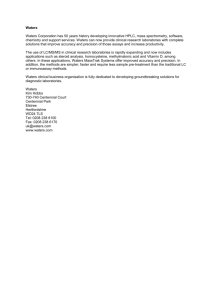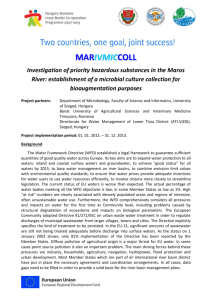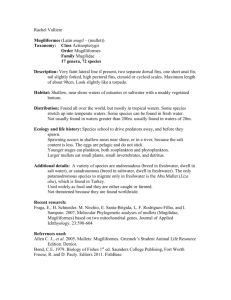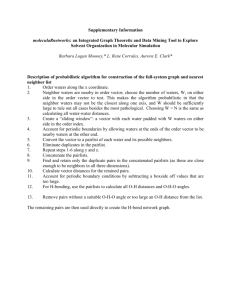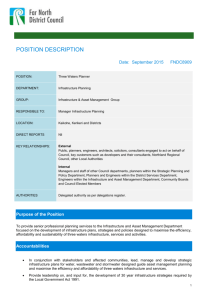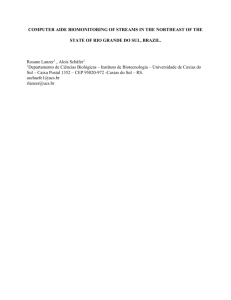Take quiz
advertisement
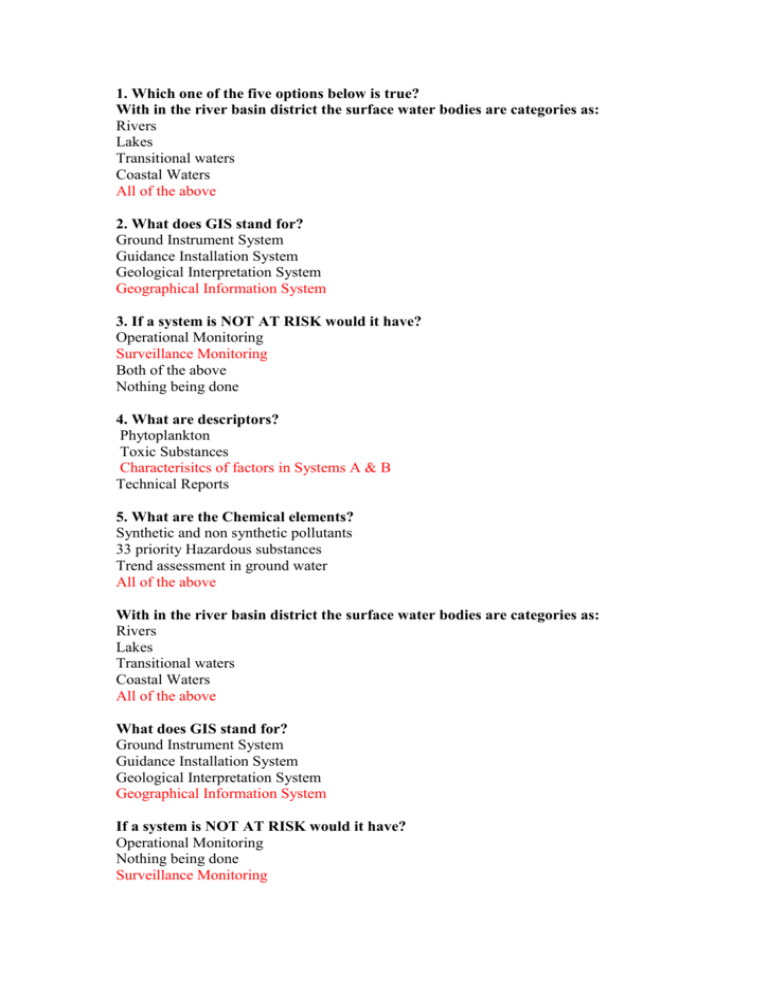
1. Which one of the five options below is true? With in the river basin district the surface water bodies are categories as: Rivers Lakes Transitional waters Coastal Waters All of the above 2. What does GIS stand for? Ground Instrument System Guidance Installation System Geological Interpretation System Geographical Information System 3. If a system is NOT AT RISK would it have? Operational Monitoring Surveillance Monitoring Both of the above Nothing being done 4. What are descriptors? Phytoplankton Toxic Substances Characterisitcs of factors in Systems A & B Technical Reports 5. What are the Chemical elements? Synthetic and non synthetic pollutants 33 priority Hazardous substances Trend assessment in ground water All of the above With in the river basin district the surface water bodies are categories as: Rivers Lakes Transitional waters Coastal Waters All of the above What does GIS stand for? Ground Instrument System Guidance Installation System Geological Interpretation System Geographical Information System If a system is NOT AT RISK would it have? Operational Monitoring Nothing being done Surveillance Monitoring What are descriptors? Phytoplankton Toxic Substances Used to describe factors in Systems A & B What are the Chemical elements? Synthetic and non synthetic pollutants 33 priority Hazardous substances Trend assessment in ground water All of the above Which are the kinds of monitoring that Members States are obliged to carry out at the beginning? Surveillance and Investigative monitoring programs Operational and Investigative monitoring programs Surveillance and Operational monitoring programs Surveillance In how many classes the monitoring network shall permit classification of water bodies? 3 4 5 6 About the sampling for river monitoring (sampling, sample handling, identification, …), you can use: ISO and EN international standards National or International methods which are equivalents Both of the above None of the above to ISO and EN In the W.F.D., reference conditions are the basis of : Ecological classification Geological classification Historical and Geographical classification All of the above When there are no relevant sites or data for a water body type, which is the Suggested Approach you can carry out for determining the Reference Conditions? Spatial network + predictive models Borrow data and use in spatial network + predictive model Site-specific data, paleoreconstruction, hind casting Use expert judgment 1) Which are the Cl- concentration standard steps by the WHO for the drinking water? 1. 200 mg.L-1 2. 300 mg.L-1 3. 400 mg.L-1 2) In most waters, sodium and chloride are tightly linked. Which are their origins? 1. Natural weathering of rock + atmospheric transport of oceanic inputs + wide variety of anthropogenic sources. 2. Natural weathering of rock + atmospheric transport of evapotranspiration + wide variety of anthropogenic sources. 3. Wide variety of anthropogenic sources + atmospheric transport of evapotranspiration + natural weathering of ground. 3) In arid and semi-arid area of the world, evapotranspiration leads to : 1. Increase in the salt content of surface waters, decrease Ca concentration, increases Na concentration. 2. Decrease in the salt content of surface waters, increase Ca concentration, decreases Na concentration. 3. Increase in the salt content of surface waters, increase Ca concentration, increases Na concentration. 4) Which ratio is a key descriptor in water for irrigation? 1. Cl/Na 2. Na/Ca 3. Na/Cl 5) The sulfate ion is highly variable in surface waters where it is linked to: 1. Sulfur-bearing minerals 2. Sulfur-bearing cations 3. Organic matter 4. All above them 6) Total suspended solids (TSS) are comprised of particles that are transported in the water column. But which kind of particles? 1. Organic particles 2. Mineral particles 3. The both 7) Times series of instantaneous TTS loads (kg.s-1) provides useful information about: 1. The biological behavior of rivers 2. The chemical behavior of rivers 3. The physical behaviors of rivers 8) If total suspended solids concentration is partly a function of discharge: 1. TSS loads increases as discharges increases 2. TSS loads decreases as discharges increases 3. TSS loads increases as discharges decreases 9) The dissolved oxygen depletion in the water body, happens above all when the turbidity is largely due: 1. To organic particles 2. To mineral particles 3. The both 10) Turbidity is a unit of measurement quantifying the degree to which light traveling through water is scattered by: 1. The suspended organic matter only 2. The suspended inorganic particles only 3. The suspended organic and inorganic particles What does typology show in ecological status assessment? Different nutrient levels and biological oxygen of demand. Similar natural biology and human disturbances. Group sites of different biology together and how they interact. All of the above Which system will euro countries most likely use? System A. System B. Both the above. Neither of the above. What is included in System A for rivers? Altitude, Longitude, Geology Longitude, Geology, Depth Size of typology based on catchments area, Valley shape, Altitude Size of typology based on catchments area, Altitude, Geology What factors are used in System B? Obligatory and Type Optional and Type Optional and Obligatory Obligatory, Optional and Type Which one of the following statements is correct for investigating monitoring? To monitor accidental pollution impacts To check biological biodiversity Pick out key chemical elements and study them All three statements are correct What is Annex IV Surface water status River basin management plans Indicative list of main pollutants Protected area Sabrina Coste What are the differences between an aquatic and terrestrial ecosystem? Viscosity of aquatic system differs from air Aquatic system contains little oxygen Aquatic system contains a lot of oxygen All of the above According to the Annex V of WFD in order to assess water quality a range of indicators are needed. Which ones? Benthic macroinvertebrate and amphibian Benthic macroinvertebrate and fish Phytobenthos and macrophytes Phytoplankton and bryophyte Transfers of energy to different organisms is called: Food key Food chain Food chain None of the above When food passes to an organism to another, what happens? Energy contained in the food is increased step by step Energy contained in the food is reduced step by step Energy contained in the food stays at the same level It depends on the temperature of the environment All organisms which share the same type of food in a food chain are: To be at the same trophic level To be at upper trophic level To be at downer trophic level None of the above Link to right definition: Holometabol insects Hemimetabol insects are insects without nymphal stage are insects with nymphal stage Hydromelidae family contains insects: Which are smaller than the Gerridae Which are bigger than the Gerridae Which are carnivorous and choose very small prey Which are herbivorous Hydromelidae family like Gerridae family can be found: On the surface of running or standing water At the bottom of the stream In the pelagic zone In any of the above habitats Most surface dwelling species are: Herbivorous Carnivorous Omnivorous There isn’t a dominant type Family Gyrinidae have a lot of morphological adaptations like: Transformation of middle and hind legs into swimming paddle Divided eyes Mandibles are tubes through All of the above The free living Turbellaria are planarians. This species: Need to have two individuals to reproduce Are hermaphrodite Can regenerate themselves if they are accidentally cut at the end of body Can regenerate themselves if they are accidentally cut in half The Gammaridae is Crustacean of the order of: Isopoda Amphipoda Mysidacea None of the above Gammaridae males: Are slighty smaller than females Are slighty bigger than females Carrying the female under him Is carrying by the female Bivalves have two equal valves and: The smaller Bivalves are hermaphrodite The smaller Bivalves are distinct sex The bigger Bivalves are distinct sex The bigger Bivalves are hermaphrodite By which means water species survive during the dry phase in temporary water?(if conditions are favorable) Survive as eggs Survive as immature stage Survive as adult All of the above XXX: Wrong What is the Chandler Score? It’s a development of the Trent Biotic Index It’s a score which take into account the abundance of each taxa It’s a score which is more sensitive to changes All of the above What is included in the Spanish BMWP and not in the UK BMWP? New family The division of score into five classes relating to different level of pollution Both of the above New genus Which is coming at the first? The UK BMWP score is a modified version of the Spanish BMWP The Spanish BMWP (BMWP’s) score is a modified version of the UK BMWP What is the standard interval between each spot-checks? 20 m 50 m 10 m None of the above Why a sweep-up checklist is also completed at the same time of recording spotchecks? Because spot-checks do not record all the information along the 500 m Because sweep-up data gives a more general description Because sweep-up takes into account features and modifications not occurring at the spot-checks All of the above Why phytoplanktons are valuable biological indicators? Because it’s easy to identify them Because it’s relatively easily sampled Because their response to nutrient enrichment is relatively well understood All of the above Phytoplankton –based systems are not currently in use in relation to the assessment of running waters although a saprobic-based system has been developed? In: Spain UK The Netherlands All of the above What categories are measured and integrated by IBI (Index Biological Integrity)? Species richness Indicator of water quality Indicator of physical habitat quality All of the above Link to technique analyses to right definition: DECORANA de-trended correspondence analyses TWINSPAN two-way indicators species analyses XXX: Wrong Which condition of oxygenation leads to the production of ammonia, carbon dioxide, and water when organic compound of sewage are un loaded in the river? Aerobic condition Anaerobic condition Both of the above Which condition of oxygenation leads to denitrification? (Nitrate to nitrogen) Aerobic condition Anaerobic condition Both of the above What happens when the hydrophobicity of xenobiotic has high level in phyto planktonic organisms? The equilibrium between pollutants concentrations in the water column and the organisms can be reached in few hours or days The equilibrium definitely cannot be reached The organism would find solution to reach the equilibrium Do zooplanktonic organisms and bacteria have exactly the same pathway to accumulate pollutants? Yes No If no, what is the other pathway zooplanktonic organisms can used to accumulate pollutants? Direct way (inner cell) Indirect way (by the food) Complete the following scheme with these following words: lake zone / filling zone / transition zone 1-Allochtonous load / 2-3-sedimentation *2 / 4-development of the primary production by phytoplankton / 5-hight turbility level / 6-low turbility level


